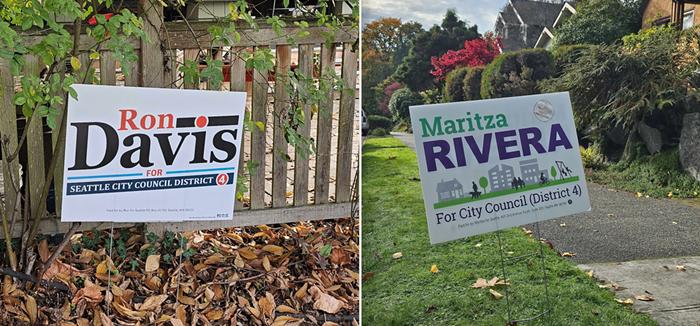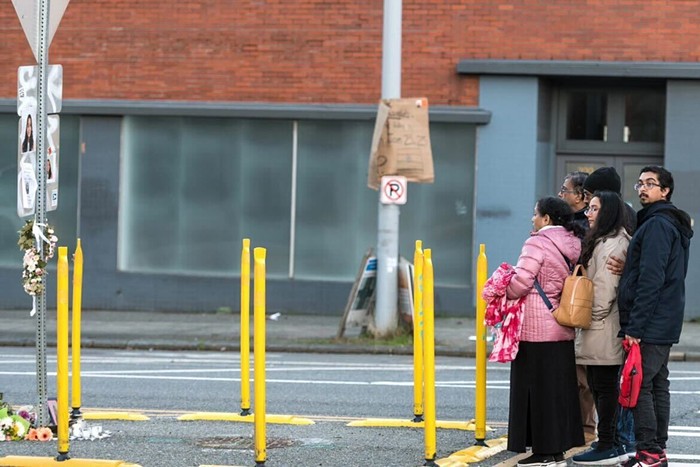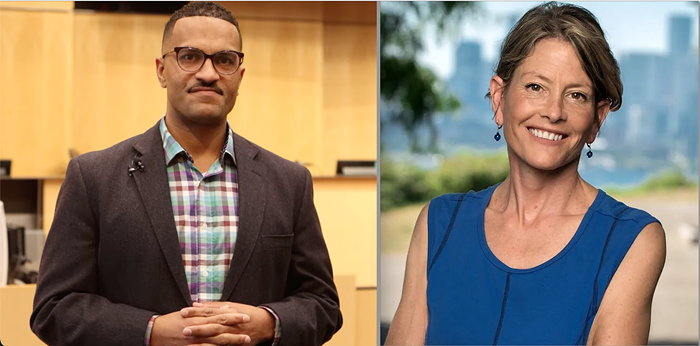It's Arts Day 2002, and nonprofit arts groups from all over the state have come to Olympia to beg for money. The idea is that during brief appointments with district representatives, arts supporters make their case about what art is good for. "We're looking for the 'wow' factor," says Gretchen Johnson, executive director of Washington State Arts Alliance, the advocacy group that organizes Arts Day. At an orientation meeting, Johnson encourages Arts Day participants to share stories about how art has improved lives or bound communities together. The point of Arts Day, she tells us, is to "build bridges," "make friendships," and "give testimony."
"We want the [state] representatives to go home and say, 'That's what those dollars mean,'" Johnson says.
As it turns out, the House has been called into session for some last-minute lawmaking, so no legislators are available to hear our stories, accept our friendship, or to receive a special tote bag filled with gifts and press materials. We drift from office to office, leaving messages with assistants in cubicles, leaving tote bags with receptionists.
Arts Day takes place every year, but this year things are particularly urgent. Because of a $1.6 billion revenue shortfall, Governor Locke has called for a 10 percent cut in the Washington State Arts Commission budget (a loss of about $287,000), the elimination of one full-time WSAC staff position, and the end of the Washington State Film Office. It's not an enormous amount, but to arts groups it feels steep--and hypocritical, as it was only in 1998 that Locke created the Governor's Blue-Ribbon Arts Task Force to "ensure that our cultural life remains strong." At the time, Washington state was ranked pitifully low in state arts funding--48th in the nation, spending 42 cents per person on the arts, against a national average of $1.44--and the 1999 increase of $750,000 was intended to address that embarrassing statistic.
But how do you complain about cuts to state arts funding when health and human services budgets are facing a proposed reduction of $235 million, a 15 percent cut? The proposed $287,000 cut to the arts budget seems insignificant by comparison. It's rare for anyone to compare funding for the arts with funding for human services, perhaps because when you stack art next to suffering, art always loses. I asked many people--arts administrators, artists, art lovers, writers--to defend spending for art against spending for people in need, and after making some heartfelt arguments about quality of life, most said that the amount of money spent on art in this country is so infinitesimal as to be inconsequential. The $287,000 being cut from the state arts budget wouldn't make much of an impact if added to the billions of dollars in the state's health and human services budget (which includes the health department, social services, and--oddly--corrections), while it would make a huge difference to the arts in Washington state.
Or would it?
REAGAN RUINED EVERYTHING
If you love art and are politically liberal, it's assumed that you support government arts funding. This line of thinking has proved quite durable, even as the philosophy behind arts funding has been warped beyond recognition.
Truly persuasive arguments for government funding of the arts are rare, and the ones you do hear--the ones made in Olympia on Arts Day--tend to involve squishy, imprecise concepts like "spirit" and "improved lives," "healing" and the "wow factor." It has become nearly impossible to talk in political terms about what art "does," about its benefits and saving graces, without resorting to burdens that should not be placed on art. But without pointing to tangible benefits, it's difficult to convince some people that the arts deserve support.
The history of public arts support in America is relatively short. The National Endowment for the Arts was born in 1965 amid much lovely speechmaking. "Art is our nation's most precious heritage," Lyndon Johnson said at the Arts and Humanities Act's signing, "for it is in our works of art that we reveal to ourselves, and to others, the inner vision which guides us as a nation."
As supportive and high-minded as this seems, Johnson had more cynical motives. According to Michael Brenson, in his book Visionaries and Outcasts: The NEA, Congress, and the Place of the Visual Artist in America (an invaluable work to which I am most indebted), Johnson, who was embroiled in an unpopular and costly war in Southeast Asia, noted the popularity of his predecessor's support of the arts. The Kennedy administration's active support of the arts--including state dinners to which artists, musicians, and writers were invited--received frequent and glowing press. To curry favor at home, Brenson believes, Johnson took the arts under his wing.
Supporting the arts was also good international PR. Johnson was fighting a Cold War against the Soviet Union and a hot war against the Vietcong. Set against strident and predictable Soviet propaganda, America's freewheeling, publicly funded artists proved that our system was superior. Freedom was the idea, and artists were given money to do what artists would do. The NEA set up a peer review panel that kept the grant process respectable and far-reaching, and the result was a roster of artists and work that defined post-Pop Art pluralism. All movements were represented (minimalism, body art, performance, video, earthworks); all kinds of artists were rewarded (Robert Irwin, Laurie Anderson, Alfredo Jaar, Gordon Matta-Clark, Carolee Schneeman, Gary Hill, Adrian Piper--one could go on).
But the freewheeling artist proved to be of fleeting political value, and things began to change with the election of Ronald Reagan and the ascendancy of the Religious Right. Instead of pointing to our open, freewheeling culture and political debate as evidence of our system's superiority, national political figures began pointing to our nation's religiosity and patriotism. "President Ronald Reagan's America, chest-thumpingly proud of its God-fearing economic and military empire," Brenson writes, "assumed, correctly, that it no longer needed to prove its tolerance for free expression to win the hearts and minds of the rest of the world." Artists, no longer "necessary," were driven out into the free market, where some became insanely rich (and many of those were mediocre Art Stars whose reputations would not survive the '80s) while others starved.
Following the famously overblown battles over the art of Andres Serrano and Robert Mapplethorpe, in 1995 Congress voted to eliminate grants to individual artists, except to writers. The NEA's budget was slashed, and only grants to arts organizations were authorized. In 1960s and '70s, the Endowment funded the process, rewarding creativity itself by making largely unrestricted grants to artists, in the hopes that they would create new and better work. Artists were given breathing room, room to experiment, room to fail. With the loss of the individual grants, this arrangement fell to pieces. Today the Endowment funds institutions, not artists, and it is finished work that is underwritten rather than the work's creation. Now the NEA and the states that have followed its lead support the exhibitors of art, the marketers of art, and arts administrators, people are unlikely to submerge a crucifix in urine, but also unlikely to ask disturbing questions. Tame and limited arts funding--the thinking seems to go--is better than no arts funding at all.
SHAMANS OF DELIGHT
At noon, the Arts Day 2002 program begins in the Legislative Building rotunda, a drafty, domed space where people speaking into the microphone are barely intelligible. To my left is a vexing piece of work, an American flag made of construction paper; the stripes look like barbed wire. It turns out they are made of hundreds of cut-out hands. The governor has failed to show up; instead, we get short speeches by Kris Tucker, executive director of the Washington State Arts Commission, WSAA Executive Director Gretchen Johnson and President Eli Ashley, and Washington State Representatives Mary Skinner and Pat Lantz. Tucker reads a poem by Kim Stafford, composed in response to September 11, which begins, "There were times when culture was a way to sweeten days/like fine cuisine... art has a job now."
The rest of the program consists of rote invocations of the "human spirit" and "community." Art is an uncritical "celebration," we are told, which suggests more about the kind of art that is possible under government funding than what art is or does. There are short performances between the comments: a woman dressed as a chicken does a musical number from a children's play; a man plays New Age music on a keyboard; a performance artist in a leotard who calls himself a "shaman of delight" and does a little dance with some rocks.
The performers are obviously good at what they do, but none of the work appeals to me. The rhetoric about "diversity of human experience" doesn't resonate at all through the performances; rather, it tells us that only certain types of human experience are acceptable under this dome, only those that confirm our best, least ambivalent feelings about ourselves. At one point, one of my companions leans over and whispers, "There aren't even any legislators here. It's just us." When the shaman of delight clicks some rocks together and hoots, I have a hard time remembering exactly why government patronage seemed like a good idea in the first place.
In Olympia on Arts Day, no one is arguing for money to fund the arts; they're looking for money to fund social therapy and politics masquerading as art. The Seattle Arts Commission's "Salmon in the City" project, for example, used some very talented artists indeed to make a political point--and hardly a controversial point at that (salmon are worth saving), or one that couldn't be effectively argued through other means. One of the state arts commission's proud selling points in 1999 was the development of a tourism plan for a rural stretch of Highway 17.
ADOLF OF THE ARTS
After the 1995 outbreak of the culture wars, the NEA was put in the position yet again of having to justify its existence. Under then-chair Jane Alexander, the Endowment put out a document that was a stunning about-face. American Canvas: An Arts Legacy for Our Communities declaimed what would come to be the NEA's justification--and therefore art's--in the coming years: The Good Cause. It announced the necessity of "transform[ing] the arts in the civic context from their present status as amenities that are added once the necessities are taken care of, into one of the primary means of addressing those necessities in the first place." Arts organizations were challenged to "place their work in a social context, making clear their stake in the community."
This was a big, big shift. Charged with addressing the country's social ills, art became a tool for helping at-risk youth, the marginalized, the silenced; art was to preserve (and sometimes "heal") the past and promote our shared values. But when did social ills become art's problem? And is art really the most effective way to address them? Of all the tools we have at hand (legislation, education, better parenting, actual psychotherapy), art is the least likely to bring about measurable change. Art's effects (especially those that run deepest, and are the hardest to name) cannot be measured--unlike the effects that Head Start or free school lunch programs might have on children's test scores. In addition, there is something profoundly condescending about the notion that inner-city kids just need a little drama after school to keep them off drugs and out of gangs.
Much of the rhetoric about art's benefits--and, conversely, its evils--has an uncomfortable historical resonance. "Art must be the handmaiden of sublimity and beauty and thus promote whatever is natural and healthy. If art does not do this, then any [public] money spent on it is squandered." So said Adolf Hitler.
Much of the pro-art rhetoric that well-meaning nonprofits make on Arts Day sounds like the kinds of arguments made during the Third Reich. In Hitler's Germany, the state was championed over the individual, the good of all over the freedom of one. When the Washington State Arts Commission's nicely designed brochure tells us that "[t]he arts contribute to the values Washington's citizens care about," I can't help but hear an echo of Hitler encouraging the artists who "in their origin and in the picture which they present... are the expressions of the soul and the ideals of the community."
LEAVE ART OUT
Government patronage of artists is a test of whether or not we're as sophisticated a democracy as we claim to be. It's one thing for all the members of a society to have the freedom to express themselves; it's something more for the government we elect to encourage expression, to fund it, to risk that this investment will not always be repaid with compliments. And it seems more important now--when even the appearance of dissent in our "unified" country brings an immediate political backlash--than it has been in the past.
Arts funding as currently practiced by our federal and state governments is lukewarm, indirect, and cowardly. The good cause has won out over the good work. In the NEA's current, glossy brochure, you can read about recent triumphs: grants to Appalachian fiddlers, an exhibition of Hmong culture, and increased access for deaf people. None of these projects is unworthy. But civilization advances by debate--and these kinds of projects don't inspire debate, but only warm, fuzzy feelings. The funding of these sorts of projects to the exclusion of other, more challenging work tells us that the government is only interested in consoling visions of who we are. Amid the proliferation of unassailable words ("heritage," "access," "cherished art form," "empowerment," "inclusion"), argument passes into tired rhetoric, and we forget what the words mean, what's really at stake. If the government can't bring back the individual grants, the peer review process, and the support of innovation and back talk, then perhaps it should get out of the arts altogether.
In Washington state, the amount of money spent on free, unlimited grants to artists barely registers (although the Seattle Arts Commission has developed a couple of new grants to address this problem). Artist Trust, the nonprofit agency that contracts with WSAC to give individual grants and fellowships to artists, receives only $68,000 per year from WSAC, about .0136 cents for every person in Washington state. I would happily double my contribution if it meant that more artists would receive direct funding for unspecified projects. In the current climate, that seems unlikely. Politicians aren't inclined to fund that type of art of their own accord, and lobbying groups like the Washington State Arts Alliance aren't asking them to.
On Arts Day, state arts groups asked the state government to keep money flowing to the "arts" (and, not incidentally, to the nonprofits that administer them), but "arts" has lost its meaning. It no longer stands for high art--museums, symphonies, opera--or for the underground--artist cooperatives, garage bands, graffiti--or even for the triangulation of these forms with pop culture. The "arts" as our state legislators and Arts Day participants define the word means something entirely different: not challenging works that might remind us that we are a complex, disunified nation of individuals, some of whom hold inconvenient opinions, but the blandest possible work, work that is meant to take the sting out of the country's ills, addressing problems we don't have the political will to solve.
At the very least it's time to take the word "art" back from the bureaucrats. Let's call the projects that the government funds "community grants," or "neighborhood grants," or "grants to minority groups." Let them build community and encourage self-esteem and use all the hollow, ugly, now-meaningless words they want--but leave art out of it.
MORE LIKE COCAINE
The only state legislator I meet on Arts Day is Ed Murray. He is extremely gracious, not at all impatient despite his busy schedule. We don't waste Murray's time with stories about how art saves lives, but go right to the heart of things: allowing nonprofit organizations to rent out spaces without losing their nonprofit status, continuing funding to the Film Office. He asks good questions, and we discuss the standardization of arts education that the state aims to have in place by 2010. This is like a parable of good government: thoughtful, mutual, and patient. It is also unnecessary; Murray, whose district includes Capitol Hill, is not unfamiliar with our arguments and has a record of supporting arts. Therefore, he's the last representative who needed to hear from us.
Now, with the benefit of a few months' perspective, Arts Day seems more like a regenerative performance than a political statement, something meant to shore up arts supporters in the essential rightness of their undertaking. In the budget passed by both houses (and not final until signed by the governor), human services loses $208 million--with approximately 25 percent of the cuts coming from social services and 16 percent coming from corrections (according to a supremely helpful fellow in the Office of Financial Management); the Department of Social and Health Services loses $44 million, or 10 percent of its budget. The Washington State Arts Commission, by contrast, loses only $86,000, a slender 1.5 percent of its budget, and the Film Office is saved--but more for financial reasons than artistic ones. (It's estimated that for every dollar the Film Office spends, it brings back $100 in revenue for the state.)
"We're a little stunned by it," says Gretchen Johnson of the relatively minor cut to the budget. "There are a lot of people hurt by the budget cuts, so we're not tooting any horns. If it were a wonderful increase in a good time, then we'd be turning cartwheels." Johnson doesn't give all of the credit to Arts Day, and cites the 1999 budget increase that was promised in return for creating and implementing a strategic plan. "The arts commission did what the legislature told them to do," she says. "That's what we've been trying to tell them--that we're doing a good job, we don't whine and cry."
So it would seem that the arts were saved in Washington. Or were they? When I think about all the artists I know who juggle multiple jobs and relative poverty to make art without government support, government-funded art seems hollow and limping and silly by comparison. Perhaps critic Dave Hickey was right when he wrote, "What if art were considered bad for us?--more like cocaine that gives us pleasure while intensifying our desires, and less like penicillin that promises to cure us all, if we maintain proper dosage, give it time, and don't expect miracles?"
Oddly, in the scope of history, it has always been fascists and arch conservatives who best understood art's power. Goebbels (who stigmatized "degenerate art" by dissidents, abstractionists, and Jews) and Jesse Helms (who wagged a frightened finger at Mapplethorpe's violent metaphysics of the body) both felt the danger of work that, like cocaine, goes straight to your bloodstream and dares to not appeal to your better self. When we tell artists that only the better self is acceptable--and lure them down that path with the enticement of government money--we destroy both art and artists.


















